Short Scope Anchoring in Deep Water
07/02/15 08:43 Filed in: Anchoring | Rocna Anchor
By Paul Shard, Copyright 2015. All rights reserved.
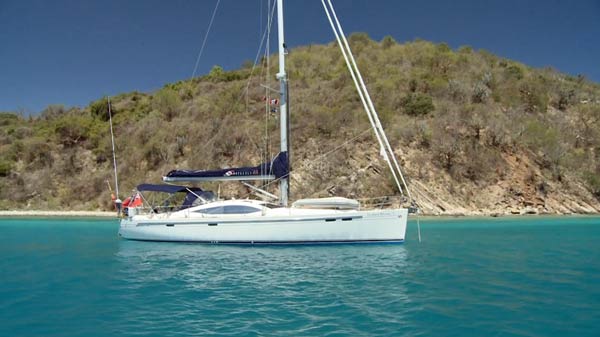
Do you ever wonder how to anchor in a crowded anchorage when the water is a bit deeper than you are used to?
Do you sometimes come into a busy anchorage and can’t to find a place to anchor where you can put out the recommended 5:1 scope?
Or do you sometimes arrive at an anchorage that is deeper than you’re used to and wonder if you have enough rode to lay out a 5:1 scope?

Welcome to the world of “short scope” deep water anchoring…
In deep anchorages that are either small or crowded Sheryl and I occasionally need to anchor with shorter scope than we would like to. In these situations we have used as little as 3:1 scope. The question is “how bad is this really?” Are there situations where you don’t really need to have the recommended 5:1 scope?
Standard “rules” say we need 5:1 scope and this is a good generalization for regular anchoring with an all-chain rode. But it doesn’t take into account the effect of having all that weight down when you have laid out a lot of chain in deep water.
If we put out 165 feet of our 3/8” chain, we have got 250 pounds of weight in chain between our anchor and the bow of our boat. This forms a curve called a catenary curve - the weight of the chain pulling down the rode even when the wind is blowing strongly. So the chain near the anchor will hopefully be pulling close along the bottom - not lifting the anchor up. But just what is the effect of this and how much can we count on it to hold the boat in place? How much of a difference will it be to having the same scope in shallower water?
Test Anchoring in Deep Water
In our test anchorage the wind is blowing 15-20 knots with gusty conditions and it is a busy but not exactly crowded anchorage. It’s deeper than normal - about 50 feet deep with a nice sandy bottom where we are anchoring. Our Rocna 33 anchor weighs 73 pounds. We have 275 feet of 3/8 G4 (G40) chain.
Water is 50 feet deep + 5 feet to the bow roller. Here is how much chain we will need to achieve different scope ratios...
5:1 Ratio 55 feet X 5 = 275 feet
4:1 Ratio 55 feet X 4 = 220 feet
3:1 Ratio 55 feet X 3 = 165 feet
The problem is that nearby boats would make it hard to find a place to lay out all our 275 feet of chain (which is the total of what we carry)
So we set out 165 feet of chain and pull back to set the anchor. This means we have a scope of just 3:1.
I calculate our Yanmar 54 hp engine with Autoprop 3 blade propellor will develop about 400-500kg of pull (1000 pounds) at full power. This is roughly equal to the force on the anchor in a gale 30-40 knots. So we are simulating a similar stress on the anchor as we are likely to experience in normal conditions if the forecast shows 20 knots and a rain squall comes through …
My goal with this setup was to dive down and see what the anchor looked like in these conditions. Would the rode be lifting up off the bottom or would the weight of the chain be holding it down on the sand?
Here are pictures from our test - engine astern at 2500 rpm simulating winds over 30 knots.
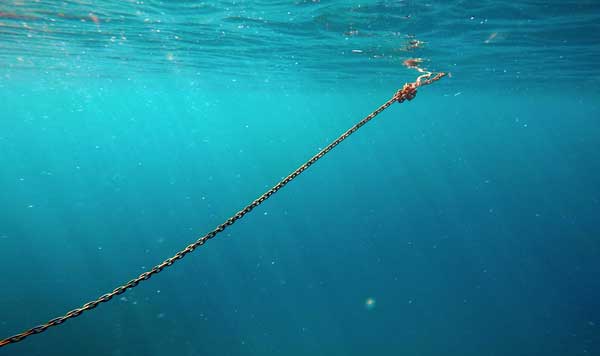
Although the chain enters the water at a steep angle this is the effect of the 250 pounds of chain. This is the effect of the catenary - the weight of the chain makes the 3:1 scope pull pretty much parallel to the bottom at roughly 30 knots of wind force. Note the chain is nearly parallel to the bottom.
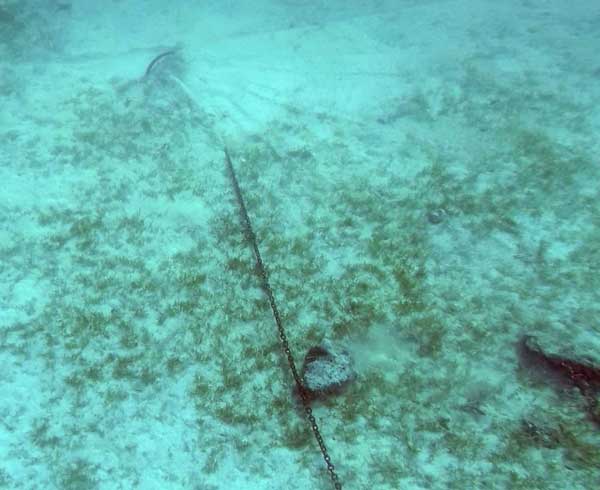
Paul dives down to take a look at it 55 feet underwater.
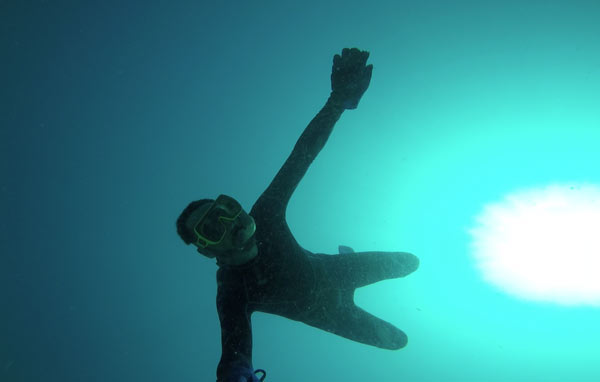
The water is nice and clear for testing here in the British Virgin Islands.
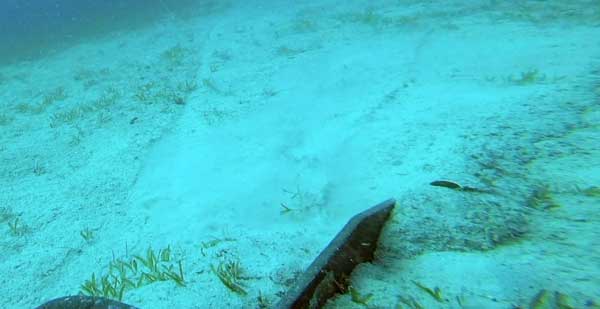
Rocna anchor set perfectly as usual... it is well buried and sitting right way up.
Cultural Differences
Anchoring is a very contentious subject and also seems to differ by culture. In North America many cruisers use a short length of chain with the rest rope. In this case the catenary method described here will not work - you need all-chain for this effect.
In the UK we rarely saw anyone anchoring with rope rode. Everyone uses all-chain rode and in many cases are anchoring in challenging crowded and tidal anchorages. Peter Nielsen of Sail Magazine comments on reducing scope with deeper water “I do agree that shallower water = greater scope. Borne out by various tests over the years. Cruising round the British coast, standard practice was 3:1 scope at HW. Often a 12-15 foot range so scope naturally increased as tide fell. “
Conclusions on Deep Water Anchoring
In normal conditions (not storm force forecast) an all chain rode will allow reduced scope in deep anchorages. We find 3:1 scope to be OK for anchoring in 50 feet of water. Increasing scope to 4:1 or 5:1 will be better and would be a good idea if strong squalls were forecast. Even an increase to 3:5:1 will make the anchor more effective (see Part 2 Crash Test here).
Additional Hints:
- It can be difficult to judge the space to your neighbours since the increased scope means you need to be further away from nearby boats. Try a range-finder app (review to follow) or a laser rangefinder example here
- Use binoculars with a rangefinder (such as our Fujinon 7X50 binos) to judge neighbourly distance.
- Use GPS and Radar to plot nearby boats.
- Ask neighbours how much rode they have out to make sure you will not hit each other.
Additional Reading on Short Scope Anchoring:
Steve Dashew - bigger anchor will allow for shorter scope if you need in deep anchorage (where you most often need it)
Go for a heavy anchor - in any given anchorage a heavier anchor will perform better than a lighter one.
Rocna designer Peter Smith discusses catenary with graphs

Catenary Calculator - give it a try!
Check out anchorages around the world with us aboard Distant Shores
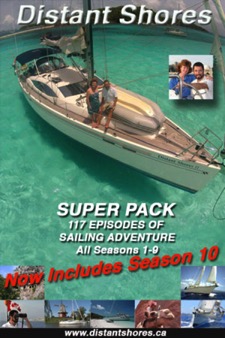
Order the Super Pack on DVD and get Season 1-10 Downloadable.
Order the Super Pack on Vimeo and we will send you the code for Season 10 as a bonus. Email us for details.
blog comments powered by Disqus